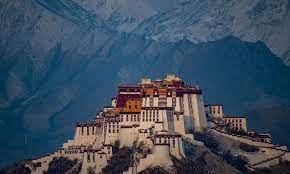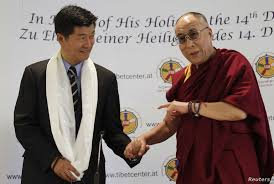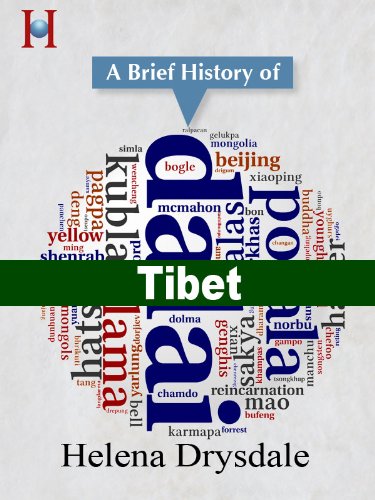GoodReads meta-data is 107 pages, rated 4.33 by three litizens.
Genre: History.
Verdict: Brisk and informative.
Tibet is a geographical expression of a vast area bounded by mountains, deserts, and rivers. It was never quite consolidated into political boundaries by its god-kings over the millennia. Absent countervailing pressures at the time, five hundreds years ago – give or take a few decades – the Buddhist tenet of reincarnation became a socio-political institution in the person of Dalai Lama, literally the big master, in a theocracy. Think of Iran today, or Vatican City.
A born ruler removes politics from the equation, as in hereditary monarchies. (Sure.) That desire to rise above locality, personality, and regional conflicts partly underlies the institution. Each incumbent Lama identifies, or hints at his successor. Yes, so far, no Madame D Lama.
Curiously, there is often a gap between the death of DL and the location, identification, and confirmation of his successor, and then the successor’s growth to manhood. In one instance it took years to find the successor who was at discovery and confirmation a boy of five or six. He was then whisked away to Lhasa and surrounded by a court of regents. One imagines that regents enjoyed regenting. The selectee is young enough to be moulded by such regents, thus assuring their pensions. The opportunities for goal displacement in this method are many.
Confirmation involves eight criteria and the scouts who locate the successor have to be satisfied that the candidate meets enough of the criteria to be THE ONE. Yeah, right. Enough. This is starting to sound like Thomas Hobbes’s analysis of political power: arbitrary.
The criteria themselves have elasticity. Location is one. When the incumbent Lama said his own last rites, did the weather vanes on the building point South? If so then the successor will be from the South, or found in the South, or maybe not. The other criteria are likewise vague, opaque, and readily challenged to a recount. Indeed there have been conflicting claims, resulting in a Double Dalai Lamas. Then there are the doctrinal conflicts among the Buddhists, which are many. It all starts to sound like Reformation Europe with its religious wars.
Though Tibet is a crossroads, there has never been a high volume of traffic on it, but Kazacks and other Muslims from the west encountered there Mongols from the North and Hans (Chinese, not Germans) from the East, and Indians from the mountainous south. In the late Nineteenth and early Twentieth Centuries when European powers competed for empire they began to intrude into this region. Defeated by the Japanese in 1905, the Russians turned this direction for softer targets. (When a serving officer in the Russian Tsar’s army, Gustav Mannerheim, later of Finland, went on an exploratory mission to these lands. He missed Shangri-La.) This move alarmed the British in India. Meanwhile, in a dying spasm the Chinese empire reached for Tibet about the same time.
Among Tibetans the major conflict has been between the candidates of the Red Hat monasteries and the Yellow Hat monasteries. In effect, this was a doctrinal religious conflict like the period of Two Popes in Europe. It involved the usual shenanigans, war, intrigue, lies, foreign alliances, theft, murder, imposters, forgery, and betrayal. A typical day in Canberra. The Yellow Hats won and the current, aged incumbent is one of their number. The Chinese propped up a Red Hat rival. It seemed a natural for the Red Chinese.
Divided among themselves, Tibetans have often been easy pickings for outsiders, though there is little in Tibet to pick. Rather the object has often been to make it a buffer between rivals, like Russia in the north and Britain (in India) in the south, the Han Chinese in the East and the Muslims in the West, and so on in the kaleidoscope of changing political alliances. Note, India and China have had numerous armed conflicts along their Himalayan border in 1962, 1967, and as recently as 2020.
Only in 1950, hot on the heels of the end of the Chinese Civil War in 1949 with all those soldiers and guns still mobilised the Beijing government reached to the far west to insure that neither the British nor the Soviets oozed into those wide open spaces. The Soviets were allies but not friends.
Chinese conquest was bad for Tibetans, especially for Buddhist. Then it got even worse with the Cultural Revolution and the Red Guards who went to Tibet to destroy. (One wonders where these geriatric Red Guards are now, and what they think of their deeds in retrospect. Pride probably. The assigned reading is Hegel on the French Revolution.) Monasteries, temples, nuns, priests, lamas, elders, books, scrolls, tapestries, prayer flags, statues, and images, everything old (defined as Tibetan) was destroyed. Savonarola came to mind with his bonfires.

Following the Great Helmsman’s demise there was a brief relaxation of the death grip of Beijing but it soon re-clenched its fists. With the subtlety of a tyrant the Chinese regime decided to out-populate Tibetans in Tibet by building roads and railroads and giving incentives to Han Chinese to go West, settle, and populate, displacing the natives. Sound familiar? Ask Crazy Horse.
There is a major irony in the efforts of the People’s Republic of China’s efforts to eradicate Buddhism in Tibet, least it infect China itself with this opiate. Chinese efforts at suppression and oppression drove Tibet Buddhism onto the world stage, and from thence it spread around the world more effectively than would have been the case if the Chinese had simply left it alone in Tibet and played a long game for generational change. Now there are Buddhist here, there, and everywhere. For years there was a large rooming-house redolent of incense and murmuring of oms full of them near us. And these external Buddhists, many of them westerners, sustain and support the Tibetan Buddhists.
In 1950 no one had ever heard of Lhamo Dhondup, that is, the Dalai Lama (14th), and now he is world figure, known everywhere and anywhere. ‘Instead of being wiped out by China, Tibetan Buddhism had spread around the world.’ thanks mainly the Chinese repression, says the author. We all obey the law of unintended consequences.

Moreover, continued Chinese repression has inspired and stimulated expatriate Tibetans to unite, and there is now a global Tibetan community with a parliament-in-exile and an elected prime minister (shown above). Check out the Facebook page for further enlightenment. The incumbent Dalai Lama renounced his secular authority in 2014, declaring that a theocracy was not the way of the future. No doubt this move was partly to head off a Chinese effort to control and manipulate the reincarnation of his successor. That has been tried before.
The Chinese, by the way, have also made it illegal to reincarnate without permission. Remember that!

The author acknowledges the propensity of Tibetans, just like so many others, to murder each other in the name of god. Buddhism is not all chanting ‘oms.’ Indeed this writer is much even-handed than the fiction writer of Water Touching Stone, discussed in an earlier post. I wanted some background while reading that novel and from a few alternatives, selected this short, easy to read book. It is volume seven (7) in a series of such brief histories. On Amazon Kindle it is credited with 107 pages, but on GoodReads is shrank to 91 pages. What’s in a number?

